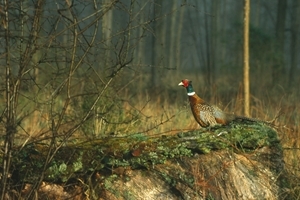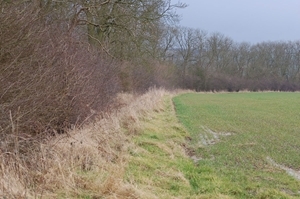 Pheasants are usually released in small woods or near to the edge of larger woodland blocks. This is because pheasants prefer the woodland fringe, an area up to 50 metres from the edge. Pheasants require regular access to open areas for sunning and feeding during winter. In spring, males hold breeding territories in open habitats along the woodland edge where they display and attract females. This association with woodland edge means that more pheasants are supported in a long thin wood or several small blocks than in one square block of a similar overall size. Likewise, the maximum number of pheasants supported in a landscape drops if woodland occupies more than half of the area.
Pheasants are usually released in small woods or near to the edge of larger woodland blocks. This is because pheasants prefer the woodland fringe, an area up to 50 metres from the edge. Pheasants require regular access to open areas for sunning and feeding during winter. In spring, males hold breeding territories in open habitats along the woodland edge where they display and attract females. This association with woodland edge means that more pheasants are supported in a long thin wood or several small blocks than in one square block of a similar overall size. Likewise, the maximum number of pheasants supported in a landscape drops if woodland occupies more than half of the area.
Within the woodland edge zone, pheasants look primarily for shrubby cover. As ground-dwelling birds, they require shelter and protection from predators. This is provided by patches of thick cover from ground level to head height and a few larger shrubs or low trees for roosting at night. Evergreens such as holly, yew and conifers make good roost trees and are often planted for this reason. However, low shrubs comprise the key component of the habitat (see below and shrub management). Wildlife strips and game cover crops next to the woodland edge, particularly on the south side of woods, increase pheasant holding capacity and wildlife value.
The best way to improve cover in ancient semi-natural and some planted woodland is to encourage the regeneration of existing plants and dormant seeds. This is achieved by allowing more light to reach the woodland floor. Creating small gaps by felling, cutting of coppice areas and maintaining wide rides also provides additional sunny sheltered conditions. Where natural regeneration fails to produce sufficient cover because of deer browsing or heavy shading, shrubs can be planted in newer woodlands or on previously unwooded sites. Non-native species should not be planted in ancient semi-natural woodland. New woodland for pheasants is best created by planting a variety of tree and shrub species mixed with open space areas.
Woodland conservation
Most woods have some wildlife value, but some are better than others. Around 38% of woodland is ancient (originating before 1600 AD). Inventories of ancient woodlands in England are available from Natural England. Many of these woods survived because they were retained for timber or the soils were unsuitable for cultivation, but now game management plays an increasing role in their maintenance. Ancient semi-natural woods are our closest link to the wildwoods of 7,000 years ago and contain native plants and animals that are often very slow to spread to new woodlands. They also support habitats rare in other woods, such as decaying wood needed by fungi and beetles, or patches of undisturbed wetland. Some of the most valuable woods have been protected through designation as Sites of Special Scientific Interest (SSSIs) and there is a legal requirement to consult Natural England over ‘Operations Likely to Damage’ (OLDs), which may include some aspects of game management. Ancient woodlands are irreplaceable and hence of particular importance. However, many other woods also contain habitats and wildlife communities of conservation interest.
The woodland edge
 In England, three quarters of woods are 10 hectares or less and have a proportionally large edge zone. A natural woodland edge commonly has a graded profile from mature trees, through scrub and young trees, to a mixture of these and the habitat outside. Such natural edges are rare in our modern countryside but can be created and maintained along roads and ridesides or open spaces within woods. Edges are diverse and many animals and plants use them, including pheasants. Valuable edge can be created by leaving a buffer of uncultivated, ungrazed field edge alongside the wood allowing the woodland areas to spread by natural colonisation.
In England, three quarters of woods are 10 hectares or less and have a proportionally large edge zone. A natural woodland edge commonly has a graded profile from mature trees, through scrub and young trees, to a mixture of these and the habitat outside. Such natural edges are rare in our modern countryside but can be created and maintained along roads and ridesides or open spaces within woods. Edges are diverse and many animals and plants use them, including pheasants. Valuable edge can be created by leaving a buffer of uncultivated, ungrazed field edge alongside the wood allowing the woodland areas to spread by natural colonisation.
New woodlands
New woods for pheasants are best located alongside existing woodland. Avoid planting woods on semi-natural habitats of value such as unimproved pasture and wetlands or as isolated blocks within open landscapes important for species such as grey partridge and stone curlew. Always seek advice from the Forestry Commission (FC) when planning new woodlands. The FC’s discretionary planting grant scheme supports the establishment of woodland habitat, including shrubs and open space, as appropriate. The GWCT’s Advisory Service can provide additional advice on new woods.